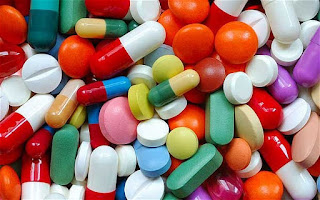. Dopamine Hydrochloride
Trade names:
Intropin, docard
Class: Direct
& indirect acting adrenergic agent.
N.B.: Available
for hospital use only on 5 ml ampoules containing 200 mg Doparninc
hydrochloride.
Pregnancy: (Category C)
Action:
Indications:
§ Cardiogenic shocks especially in M.I. associated with sever
C.H.F § Hypotension due to poor cardiac out
put.
§ Shock associated with septicemia, trauma, heart surgery, renal
failure & C.H.F.
§ Cardiomyopathy.
§ In lower doses (1-5 Mcg/kg/min) used in renal failure.
Contraindications:
§ Pheochromocytoma, uncorrected tachycardia, arrhythmias.
§ Hypovolemia.
§ Safety and efficacy is not established in children.
Side effects:
§ GI: Nausea and vomiting.
§ CV: Ectopic heart-beats, tachycardia or bradycardia, anginal
pain, palpitation, hypotension or hypertension, dyspnea, wide QRS complex. § Others: headache.
Dosage and
administration:
N.B.: This is a potent drug.
It must be diluted
before administration to the patient.
Suggested
dilution:
Transfer contents of
one ampoule (5ml containing 200 mg of dopamine) by aseptic technique to either
250 or 500 ml bottle of sterile I.V. solution (saline, dextrose 5% or ringer
lactate). These dilutions will yield a final concentration for administration
as follows.
-
250 ml dilution contains
800 mcg\ml of dopamine.
-
500 ml dilution contains
400 mcg\ml of dopamine. N.B.:
1- Solution stable after dilution for 24 hours.
2- Don’t add dopamine to NaHCO3 or other alkaline I.V. solutions
since the drug is inactivated in alkaline solution.
Rate
of administration.
Through a suitable I.V. needle or a
catheter & through an electronic infusion pump, rate is regulated according
to required dose.
Dose:
Renal dose: 1-5
Mcg\kg\minute.
Cardiac dose:
start initially of 5 Mcg/kg/min then increase by increments up to a rate of
20-50 Mcg/kg/min.
Nursing
considerations:
§ Administer only by IV INFUSION (Not IV bolus nor IM) § Drug must be diluted before use.
§ Administer drug through a central line or a big vein (vein in
the anticupital fossa is preferred over those in the hand).
§ Stop the drug by small increments.
§ Solution is stable for 24 hrs, protect it from light.
§ Monitor B.P. & ECG continuously during drug administration.
§ Monitor intake & out put.
§ Monitor patient for occurrence of side effects.
§ Check I.V. site for sighs of extravasations.
§ Drug should be administered through electronic infusion device.




